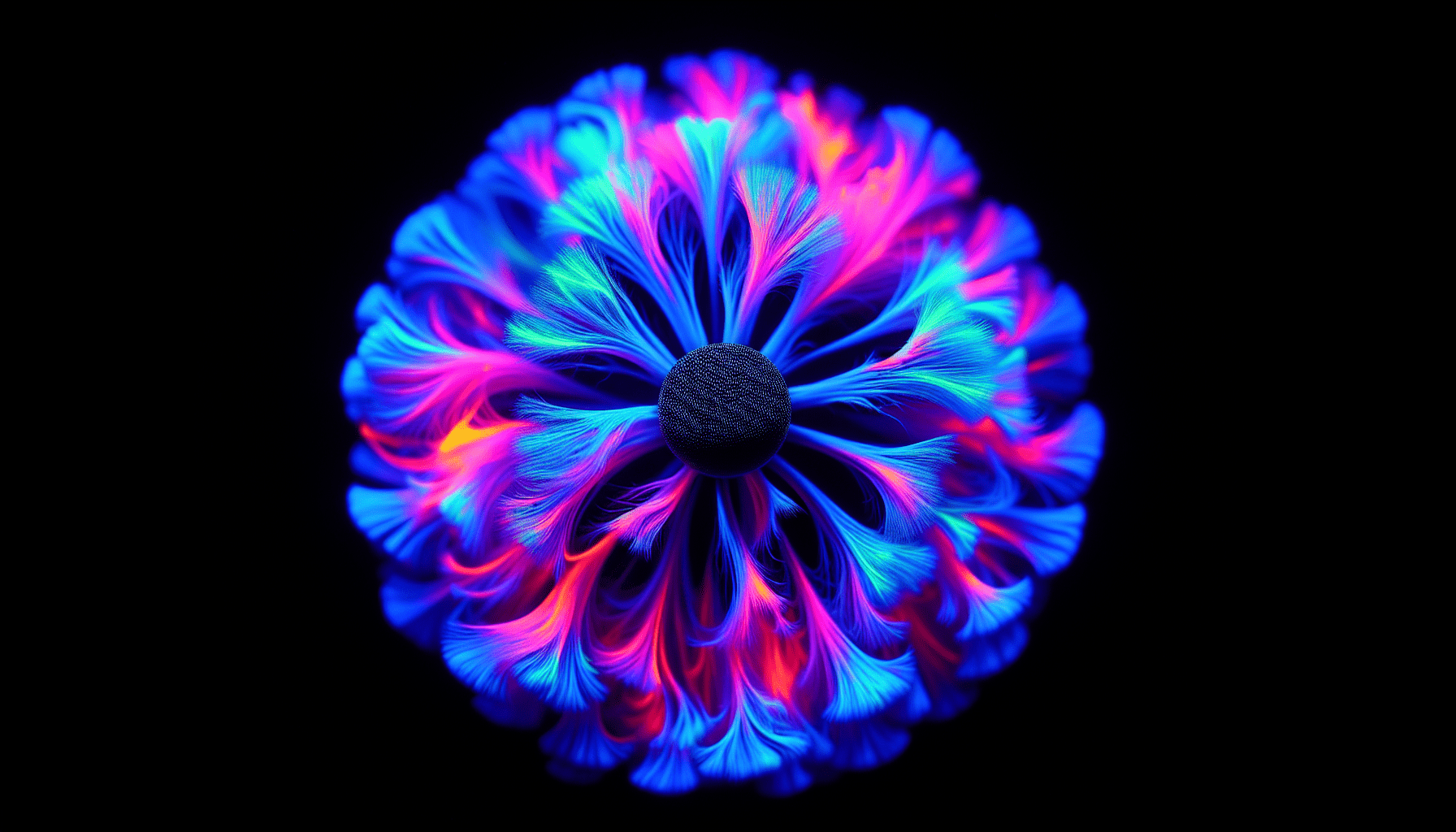Fluorescent paint is an incredibly versatile medium that can elevate the visual impact of any artwork or project. In this article, you will discover the essential techniques and tips to effectively utilize fluorescent paint. Whether you’re an experienced artist looking to add a vibrant touch to your creations or a DIY enthusiast wanting to transform your living space, this guide will provide you with the knowledge and skills needed to make the most of this luminous and exciting medium. Get ready to unleash the fluorescent magic and create stunning pieces that capture attention and inspire awe.

Choosing the Right Fluorescent Paint
Understanding Fluorescent Paint
Fluorescent paint is a unique type of paint that contains phosphors, which are substances that emit visible light when exposed to ultraviolet (UV) light. This gives fluorescent paint its vibrant and eye-catching qualities, making it a popular choice for various applications such as arts and crafts, party decorations, and signage. Understanding how fluorescent paint works is essential in choosing the right paint for your specific project.
When UV light hits the phosphors in fluorescent paint, it excites the electrons within the phosphor molecules, causing them to move to a higher energy state. As these electrons return to their original energy state, they release the excess energy in the form of visible light, creating the bright and glowing effect characteristic of fluorescent paint. It is important to note that fluorescent paint does not actually produce light on its own; instead, it absorbs and re-emits light from other sources.
Considerations for Choosing Fluorescent Paint
When choosing fluorescent paint, there are several important considerations to keep in mind. Firstly, consider the intended application of the paint. Are you looking to create vibrant and eye-catching artwork, or are you planning to use the paint for functional purposes, such as safety signage? Different types of fluorescent paint may be better suited for specific applications.
Another factor to consider is the color of the fluorescent paint. Fluorescent paints come in a wide range of colors, each with its own unique properties and intensity. It is important to choose a color that aligns with your desired aesthetic and the atmosphere you want to create.
Additionally, consider the surface on which you will be applying the fluorescent paint. Some surfaces may require specific types of fluorescent paint or additional surface preparation to ensure proper adhesion. It is crucial to read the manufacturer’s instructions and recommendations to ensure the paint adheres well and achieves the desired effect on your chosen surface.
Different Types of Fluorescent Paint
There are various types of fluorescent paint available on the market, each with its own unique characteristics and intended uses. Some common types include acrylic fluorescent paint, solvent-based fluorescent paint, and water-based fluorescent paint.
Acrylic fluorescent paint is versatile and can be used on a wide range of surfaces such as wood, metal, and canvas. It dries quickly and offers good durability, making it suitable for both indoor and outdoor applications. However, it is important to note that some acrylic fluorescent paints may require a topcoat or varnish to protect and preserve the paint’s fluorescent properties.
Solvent-based fluorescent paint is typically used for outdoor applications, as it offers excellent weather resistance. It is also known for its high gloss finish and vibrant colors. However, it is important to use this type of paint in a well-ventilated area due to the strong fumes associated with solvent-based products.
Water-based fluorescent paint is a safer and more environmentally friendly option compared to solvent-based alternatives. It is easy to clean up with water, dries quickly, and produces vibrant colors. This type of paint is suitable for both indoor and outdoor use and is often chosen for applications such as arts and crafts projects.
When choosing the right type of fluorescent paint, considering factors such as the application, color, surface, and desired durability will help you make an informed decision that aligns with your specific project needs.
Preparation and Safety
Gathering the Necessary Supplies
Before starting your fluorescent paint project, it is important to gather all the necessary supplies to ensure a smooth and efficient process. Here are some essential supplies you may need:
-
Fluorescent paint: Ensure you have enough paint for your entire project, taking into account the number of coats you plan to apply.
-
Brushes or rollers: Choose brushes or rollers suitable for the size of your project and the type of surface you will be painting on.
-
Protective equipment: Depending on the type of fluorescent paint and the application method, you may need safety goggles, gloves, a mask, and appropriate clothing to protect yourself from fumes and paint splatters.
-
Surface preparation tools: This may include sandpaper or sanding block, primer, tape, and cleaning supplies.
-
Ventilation: If you are working indoors, consider having proper ventilation, such as an open window or a fan, to ensure the fumes dissipate and provide a safe working environment.
By gathering all these supplies beforehand, you can ensure a seamless painting process without interruptions or the need to pause and search for missing items.
Preparing the Work Area
Preparing the work area is crucial for achieving optimal results when using fluorescent paint. Here are some steps to follow:
-
Clear the space: Remove any furniture, objects, or decorations that could hinder your painting process or be accidentally splattered with paint.
-
Cover the floor and nearby surfaces: Use drop cloths or plastic sheets to protect the floor and surfaces that are not intended to be painted. This will prevent accidental spills and splatters from damaging surrounding areas.
-
Adequate lighting: Ensure the work area is well-lit to accurately see the surface and ensure even coverage of the fluorescent paint. Natural daylight or bright artificial lighting is ideal for this purpose.
-
Temperature and humidity control: Fluorescent paint performs best under certain temperature and humidity conditions. Aim for an environment with moderate temperature and humidity levels to ensure proper drying and curing of the paint.
By taking the time to properly prepare the work area, you can minimize the risk of accidents, achieve better paint application, and maintain a clean and organized workspace.
Protective Measures
When working with fluorescent paint, it is important to prioritize safety and take appropriate protective measures. Here are some key precautions to consider:
-
Ventilation: Ensure proper ventilation in the work area to prevent the buildup of fumes. If you are working indoors, open windows or use fans to circulate fresh air. If working outdoors, ensure you have adequate airflow.
-
Personal protective equipment (PPE): Wear safety goggles to protect your eyes from paint splatters or fumes. Use gloves to prevent direct contact with the paint, and a mask to avoid inhaling potentially harmful fumes. Additionally, wear appropriate clothing that covers your skin to minimize direct exposure to the paint.
-
Hygiene: Wash your hands thoroughly after handling fluorescent paint, even if wearing gloves. Avoid touching your face or other surfaces until you have properly cleaned your hands to prevent accidental contamination.
-
Storage and disposal: Properly store any unused paint in a cool and dry area, away from direct sunlight or extreme temperatures. Follow the manufacturer’s instructions for proper disposal of paint containers and any excess paint to minimize environmental impact.
By implementing these protective measures, you can ensure a safe and healthy painting experience, reducing the risk of accidents or exposure to harmful substances.
Surface Preparation
Cleaning the Surface
Before applying fluorescent paint, it is essential to thoroughly clean the surface to ensure proper adhesion and longevity of the paint. Here are some steps to follow when cleaning the surface:
-
Remove any loose or flaking paint: Use a scraper or putty knife to remove any old, loose, or peeling paint. This will create a smooth and clean surface for the fluorescent paint to adhere to.
-
Clean with soap and water: Wash the surface with a solution of mild soap or detergent and water to remove any dirt, grease, or contaminants. Use a sponge or cloth to scrub the surface gently, ensuring you reach all areas that will be painted.
-
Rinse thoroughly: Rinse the surface with clean water to remove any soap residue. This step is crucial to prevent any interference between the paint and the surface.
-
Allow the surface to dry completely: Ensure the surface is completely dry before proceeding to the next step. Moisture can hinder paint adhesion and lead to poor results.
Cleaning the surface thoroughly will ensure proper paint adhesion and minimize the risk of peeling or flaking in the future.
Sanding and Priming
In some cases, sanding and priming may be necessary to achieve the best results when using fluorescent paint. Here’s when and how to apply these additional steps:
-
Sanding: If the surface has imperfections, rough areas, or an existing glossy finish, gentle sanding can help create a smoother surface for the paint. Use sandpaper or a sanding block with a fine grit to lightly sand the surface.
-
Clean the surface again: After sanding, clean the surface using the same steps mentioned earlier. This will remove any dust or debris generated during the sanding process.
-
Priming: Depending on the type of surface and paint you are using, applying a primer can enhance adhesion and promote a more even finish. Use a primer specifically designed for the type of surface you are working on, and follow the manufacturer’s instructions for proper application.
Sanding and priming are particularly important when working on uneven surfaces, surfaces with existing paint or coatings, or surfaces that require optimal adhesion for long-term durability.
Taping Off Areas
If your project involves areas that should not be painted, such as edges or intricate designs, taping off these areas will help achieve clean and precise lines. Here’s how to tape off areas effectively:
-
Use painter’s tape: Use a high-quality painter’s tape that is specifically designed for clean paint lines. Avoid using regular masking tape, as it may not provide the same level of adhesion and could result in bleeding or uneven lines.
-
Plan the areas to be taped: Identify the areas that should not be painted and plan how you will tape them off. Measure and mark the areas as needed to ensure accuracy.
-
Apply the tape: Carefully apply the painter’s tape along the marked lines, ensuring it adheres well to the surface. Press down firmly to create a seal and prevent paint from seeping underneath.
-
Smooth the edges: To further prevent paint bleed, run a putty knife or credit card along the edge of the tape to create a tight seal. This will help ensure sharp lines once the paint is applied.
Taping off areas will help create crisp and defined edges, especially when working on projects that require intricate designs or multiple colors.
Applying the Fluorescent Paint
Stirring the Paint
Before applying fluorescent paint, it is important to stir the paint thoroughly to ensure an even distribution of pigments and color consistency. Here’s how to stir the paint effectively:
-
Select a suitable stirring tool: Use a clean stirring stick or a paint mixing paddle attached to a power drill. Ensure the tool is clean and free of any contaminants that could affect the paint’s quality.
-
Stir in a circular motion: Insert the stirring tool into the paint container and stir in a circular motion. Start from the bottom of the container and gradually work your way up to incorporate all layers of paint.
-
Continue stirring until well-mixed: Stir the paint for several minutes to ensure all pigments are properly blended. Pay attention to any areas of the container that may have concentrated pigments and make sure they are thoroughly mixed.
-
Check for consistency: Once stirring is complete, check the paint’s consistency. The paint should flow smoothly and evenly without lumps or clumps. If necessary, add a small amount of compatible thinner or water, following the manufacturer’s instructions, to achieve the desired consistency.
Stirring the paint effectively will ensure a uniform color and optimal paint performance throughout the application process.
Choosing the Right Application Method
The choice of application method for fluorescent paint depends on the type of project and the desired outcome. Here are some common application methods to consider:
-
Brushes: Traditional paintbrushes are suitable for small areas, intricate designs, and projects that require precision. Choose brushes with synthetic bristles, specifically designed for acrylic or water-based paints, to ensure smooth and even application.
-
Rollers: Paint rollers are ideal for larger areas such as walls, ceilings, or floors. They provide quick and efficient coverage, especially when working with a larger amount of fluorescent paint. Use a roller cover suitable for the type of paint you are using and consider a longer nap for rough or textured surfaces.
-
Airbrushing: Airbrushing is a technique commonly used in artistic projects and detailed designs. It allows for precise control of paint application and can create a smooth, even finish. However, airbrushing requires specialized equipment and skills.
-
Spray guns: Spray guns are an option for larger projects or applications that require a high level of coverage. They provide a fast and efficient way to apply fluorescent paint. However, spray guns require proper equipment, setup, and adequate ventilation due to the potential for overspray and fumes.
Consider the size of your project, the level of detail required, and the equipment available to determine the most suitable application method for your specific needs.
Applying Multiple Coats
To achieve the desired vibrancy and coverage with fluorescent paint, applying multiple coats is often necessary. Here are some tips for applying multiple coats effectively:
-
Allow proper drying time between coats: Follow the manufacturer’s instructions regarding drying time between coats. Applying a new coat of paint before the previous coat is properly dry can lead to smudging or lifting of the paint.
-
Apply thin, even coats: Rather than applying one thick coat, it is better to apply multiple thin coats. This allows for better control over the paint’s opacity and minimizes the risk of uneven application or dripping.
-
Check for even coverage: After each coat has dried, inspect the surface for any areas of uneven coverage or missed spots. Touch up these areas with additional coats as needed to ensure a consistent and vibrant finish.
-
Follow recommended coat thickness: Fluorescent paint, like any other type of paint, has a recommended coat thickness to achieve the best results. Applying coats that are too thin may result in a translucent finish, while coats that are too thick may cause the paint to crack or peel. Following the manufacturer’s guidelines will ensure optimal application.
By applying multiple coats properly, you can achieve a vibrant, long-lasting finish that truly showcases the fluorescent properties of the paint.

Drying and Curing
Understanding Drying and Curing Times
After applying fluorescent paint, allowing sufficient drying and curing time is crucial for optimal performance and longevity. It is important to understand the difference between drying and curing:
-
Drying: Drying refers to the time it takes for the solvent or water in the paint to evaporate. During this stage, the paint surface may feel dry to the touch, but it is not fully hardened or cured. The drying time can vary depending on the type of paint, application thickness, and environmental conditions.
-
Curing: Curing is the chemical process that occurs after the paint has dried. During this stage, the paint undergoes molecular changes, forming a durable and hard surface. Curing times can range from several days to several weeks, depending on various factors such as the type of paint, temperature, humidity, and ventilation.
It is crucial to follow the manufacturer’s instructions regarding drying and curing times to ensure the paint fully sets and achieves its intended properties. Premature handling or exposure to moisture before the paint has cured can result in surface damage or poor adhesion.
Creating Proper Ventilation
Proper ventilation is essential during the drying and curing process to ensure the paint dries evenly, prevent fume buildup, and maintain a safe working environment. Here’s how to create proper ventilation:
-
Open windows and doors: If you are working indoors, open windows and doors to allow fresh air to circulate. Cross ventilation is ideal, as it promotes faster drying and helps dissipate any paint fumes.
-
Use fans or air purifiers: If natural ventilation is not sufficient, use fans or air purifiers to improve air circulation. Place the fans strategically to direct air towards the painted surface, aiding in the drying process.
-
Avoid stagnant air: Stagnant air can prolong the drying process and result in uneven curing. Use fans to create airflow or reposition the fans periodically to keep the air circulating around the painted surface.
Proper ventilation not only ensures the paint dries and cures efficiently but also helps minimize the inhalation of potentially harmful fumes.
Temperature and Humidity Considerations
Temperature and humidity play a significant role in the drying and curing process of fluorescent paint. Here are some important considerations:
-
Ideal temperature range: Fluorescent paint typically performs best within a specific temperature range. Avoid painting in extreme temperatures, as it can affect paint adhesion and drying time. Aim for a moderate temperature, ideally between 60-77°F (15-25°C), for optimal results.
-
Avoid high humidity: High humidity can prolong drying times and create a sticky finish. Aim for a humidity level below 60% to ensure the paint dries and cures properly. If necessary, use dehumidifiers or air conditioners to control the humidity in the work area.
-
Low humidity precautions: In extremely dry or low humidity conditions, the paint may dry too quickly, leading to poor adhesion. In such cases, lightly misting the surface with water or using a humidifier can help maintain a suitable environment for paint drying.
By considering temperature and humidity levels during the drying and curing process, you can ensure the fluorescent paint achieves its desired characteristics and maintains good durability.
Enhancing the Fluorescent Effect
Using a White Basecoat
Using a white basecoat can significantly enhance the fluorescent effect of the paint, especially when working with darker or colored surfaces. Here’s why and how to use a white basecoat:
-
Reflective properties: A white basecoat acts as a reflective surface, helping to maximize the intensity and luminosity of the fluorescent paint. It provides a bright and neutral background for the fluorescent pigments to radiate from.
-
Improved color accuracy: Applying a white basecoat before the fluorescent paint allows the true color of the fluorescent pigments to shine through without interference from the underlying surface.
-
Smooth and consistent coverage: A white basecoat ensures an even and consistent coverage of the fluorescent paint. It helps prevent the underlying surface color from influencing the visibility or vibrancy of the fluorescent pigments.
To use a white basecoat, first, ensure the surface is properly cleaned and prepared. Apply a layer of white paint, allowing it to dry completely before proceeding with the fluorescent paint application. Follow the manufacturer’s instructions regarding drying times and recommended application techniques for the white basecoat.
Layering Techniques
Layering is a technique that involves applying multiple layers of fluorescent paint to achieve depth and dimension in the finished piece. Here are some tips for effective layering:
-
Choose complementary colors: Select colors that complement each other to create contrast and visual interest. Consider using lighter and darker shades of the same color or combining complementary colors on the color wheel.
-
Allow drying time between layers: Ensure each layer of paint is completely dry before applying the next. This prevents the paint from lifting or mixing with the previous layer and maintains the integrity of the fluorescent effect.
-
Experiment with transparency: Adjust the opacity of each layer to experiment with different levels of transparency. Applying thin, translucent layers can create a subtle and ethereal effect, while thicker, opaque layers offer a bolder and more vibrant appearance.
Layering fluorescent paint allows for creative exploration and the potential to achieve unique effects that capture attention and highlight the fluorescent properties of the paint.
Using UV Lighting
To enhance the fluorescent effect even further, consider incorporating UV lighting into your project. UV lighting emits ultraviolet rays that cause the fluorescent paint to glow even brighter. Here’s how to use UV lighting effectively:
-
Select the right UV light source: Choose a UV light source that emits a sufficient amount of ultraviolet rays. Consider options such as blacklight tubes, LED UV lights, or UV light strips. Ensure the wavelength of the UV light matches the fluorescent paint’s specific requirements.
-
Position the UV lights strategically: Place the UV lights in a way that maximizes the exposure of the fluorescent paint. Consider the angle, distance, and coverage area to achieve the desired effect. Test different positioning options to find the most effective configuration.
-
Test the lighting conditions: Before permanently installing the UV lights, conduct tests to determine the optimal lighting conditions. Observe the fluorescent paint under different lighting setups to ensure the desired level of brightness and glow.
Remember to exercise caution when working with UV lighting, as prolonged exposure to strong UV rays can be harmful to the eyes and skin. Wear appropriate eye protection and limit exposure to UV lighting when not needed.
By incorporating a white basecoat, utilizing layering techniques, and strategically using UV lighting, you can take full advantage of the fluorescent effect and create visually striking and captivating projects.
Maintenance and Longevity
Cleaning and Caring for Fluorescent Surfaces
Proper cleaning and maintenance are essential for preserving the vibrant and long-lasting properties of fluorescent paint. Here are some guidelines for cleaning and caring for fluorescent surfaces:
-
Use non-abrasive cleaning materials: When cleaning fluorescent surfaces, use non-abrasive materials such as a soft cloth or sponge. Abrasive cleaners or harsh scrubbing can damage the paint’s finish and dull its fluorescent properties.
-
Avoid harsh chemicals: Do not use strong chemicals or solvents when cleaning fluorescent surfaces, as they can strip away the paint or cause discoloration. Opt for mild soap or detergent mixed with water to clean the surface gently.
-
Dry surfaces gently: After cleaning, gently pat the surface dry with a soft cloth or allow it to air dry. Avoid rubbing forcefully, as this can cause the paint to peel or flake.
-
Handle with care: Prevent scratches or chips on fluorescent surfaces by handling them carefully. Avoid placing heavy or sharp objects directly on the painted surface.
By following these cleaning and care guidelines, you can maintain the vibrancy and integrity of your fluorescent surfaces, ensuring they continue to stand out and attract attention.
Avoiding Exposure to Direct Sunlight
Fluorescent paint can be sensitive to prolonged exposure to direct sunlight. UV rays from the sun can cause fading or discoloration over time. To prevent this, consider the following precautions:
-
Indoor placement: Whenever possible, place fluorescent-painted objects or surfaces indoors or in areas that are shielded from direct sunlight. This will help minimize exposure to harmful UV rays.
-
UV protection: If the painted surface will be exposed to sunlight, consider applying a clear UV-protective topcoat specifically designed for use with fluorescent paint. This can help minimize UV damage and extend the life of the fluorescent finish.
-
Regular inspection: Periodically inspect the fluorescent surfaces for any signs of fading or discoloration. Promptly address any issues to prevent further degradation of the paint.
By taking these precautions, you can enjoy the vibrant and eye-catching qualities of fluorescent paint for longer periods without worrying about premature fading or discoloration.
Repainting and Touch-ups
Over time, fluorescent paint may require repainting or touch-ups to maintain its visual impact. Here’s how to approach repainting or touch-ups effectively:
-
Evaluate the condition: Regularly assess the condition of the fluorescent paint. Look for signs of peeling, chipping, fading, or discoloration. If the surface shows significant wear or damage, repainting may be necessary.
-
Surface preparation: Before repainting or touching up, clean the surface thoroughly and address any issues such as peeling or chipping paint. Follow the steps mentioned earlier for surface preparation to ensure optimal adhesion and smooth application.
-
Match colors accurately: When repainting or touching up, ensure you select fluorescent paint that closely matches the existing color. This will help maintain the original aesthetic and coherence of the project.
-
Apply thin layers: To achieve a seamless and consistent finish, apply thin layers of fluorescent paint while following the recommended drying and curing times between coats.
By periodically repainting or touching up your fluorescent surfaces, you can keep them looking vibrant and fresh, ensuring they continue to make a visual impact.
Creative Ideas and Projects
Glow-in-the-Dark Art
Fluorescent paint is commonly used to create mesmerizing glow-in-the-dark art pieces. By using UV lighting or charging the paint with other light sources, the artwork can emit an ethereal glow in low-light conditions. Paintings, sculptures, or murals can be transformed into captivating displays that draw the viewer’s attention.
To create glow-in-the-dark art, start with a white basecoat to enhance the fluorescent effect. Layer the fluorescent paint to create depth and dimension. Consider using different brushstroke techniques, blending colors, or incorporating stencils for added creativity. Experiment with UV lighting placement to achieve the desired glowing effect and adjust the lighting conditions as needed.
Fluorescent Party Decorations
Fluorescent paint is an excellent choice for creating vibrant and attention-grabbing party decorations. Whether it’s a themed birthday party, a neon dance party, or a glow-in-the-dark event, fluorescent paint can add an extra flair to the decorations. Here are some ideas:
-
Neon banners and signs: Paint colorful messages or designs on banners and signs using fluorescent paint. Hang them around the venue to create an exciting atmosphere.
-
Glow-in-the-dark balloons: Use fluorescent paint to create unique designs on balloons. Once inflated, the paint will react to UV lighting or other light sources, creating a captivating glow effect.
-
Neon table centerpieces: Paint jars, vases, or other containers with fluorescent paint to transform them into eye-catching centerpieces. Add flowers or LED lights for a vibrant and dynamic look.
-
UV-reactive cloth or tablecloths: Dye or paint fabrics with fluorescent pigments to create UV-reactive cloth or tablecloths. When under UV lighting, the fabric will emit a dazzling glow, adding a magical touch to any event.
Fluorescent Signage
Fluorescent paint is widely used for creating highly visible and attention-grabbing signage. Whether it’s safety signage, promotional signs, or artistic installations, fluorescent paint ensures maximum visibility in various settings. Here are some considerations:
-
Contrast and legibility: Choose contrasting colors for the background and text to ensure easy readability. Fluorescent paint against a black background or vice versa creates a striking contrast.
-
Size and placement: Consider the viewing distance and angle when determining the size and placement of the signage. Ensure the sign is easily visible from different perspectives to optimize its impact.
-
UV lighting integration: If possible, incorporate UV lighting to enhance the fluorescent effect of the signage. This can be particularly effective for signs displayed in low-light or nighttime environments.
Fluorescent signage can effectively communicate important messages or attract attention in both indoor and outdoor settings. It is an excellent choice for businesses, events, or public spaces where visibility and impact are crucial.
Tips and Tricks
Testing the Paint on a Small Surface
Before starting your main project, it is always a good idea to test the fluorescent paint on a small and inconspicuous surface. This allows you to assess the color vibrancy, coverage, and drying time of the paint. Additionally, testing the paint can help identify any potential compatibility issues with the surface or other materials used in your project. By conducting a small test, you can make any necessary adjustments or modifications before proceeding with the entire project, ensuring optimal results.
Practicing Different Application Techniques
Different application techniques can create unique effects with fluorescent paint. By practicing different techniques on a spare surface or canvas, you can familiarize yourself with the possibilities and refine your skills. Some techniques to explore include blending colors, creating gradients, using different brushstrokes, or experimenting with different tools such as sponges or palette knives. Practice and experimentation will help you develop your own style and expand your creative possibilities.
Mixing Fluorescent Paint Colors
Fluorescent paint colors can be mixed to create custom shades and variations. When mixing fluorescent paint colors, keep the following in mind:
-
Use a palette or mixing tray: Use a clean palette or mixing tray to combine the colors. This allows you to control the color intensity and create a consistent mixture.
-
Start with small amounts: Begin with small amounts of each color to ensure you achieve the desired shade. You can always add more paint if needed, but it is challenging to lighten the color once it becomes too dark.
-
Mix thoroughly: Use a clean brush or palette knife to mix the colors thoroughly. Ensure there are no streaks or lumps, and the pigments are evenly blended.
By experimenting with color mixing, you can create unique and personalized shades of fluorescent paint to bring your creative vision to life.
Conclusion
Choosing the right fluorescent paint and applying it correctly can lead to stunning and visually captivating results. By understanding the characteristics of fluorescent paint, preparing the work area properly, and following the recommended application techniques, you can achieve vibrant and long-lasting finishes. Remember to consider factors such as surface preparation, drying and curing times, ventilation, and temperature and humidity control to ensure optimal results.
Fluorescent paint offers endless possibilities for creative projects, from glow-in-the-dark art to decorative party elements and attention-grabbing signage. By embracing the unique properties of fluorescent paint and incorporating techniques such as layering, using a white basecoat, and integrating UV lighting, you can unleash your creativity and embark on exciting and imaginative projects.
Keep in mind the importance of proper maintenance and care to preserve the vibrancy and longevity of fluorescent surfaces. Regular cleaning, avoiding direct sunlight, and addressing any signs of wear or fading through repainting or touch-ups will ensure your fluorescent projects continue to make a statement.
Immerse yourself in the world of fluorescent paint, explore the limitless possibilities, and let your creativity shine with vibrant and awe-inspiring results.



